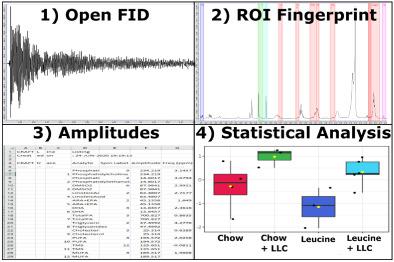当前位置:
X-MOL 学术
›
Magn. Reson. Chem.
›
论文详情
Our official English website, www.x-mol.net, welcomes your
feedback! (Note: you will need to create a separate account there.)
CRAFT for NMR lipidomics: Targeting lipid metabolism in leucine-supplemented tumor-bearing mice
Magnetic Resonance in Chemistry ( IF 1.9 ) Pub Date : 2020-09-22 , DOI: 10.1002/mrc.5092 Hayden Johnson 1 , Melissa Puppa 2 , Marie van der Merwe 2 , Aaryani Tipirneni-Sajja 1
Magnetic Resonance in Chemistry ( IF 1.9 ) Pub Date : 2020-09-22 , DOI: 10.1002/mrc.5092 Hayden Johnson 1 , Melissa Puppa 2 , Marie van der Merwe 2 , Aaryani Tipirneni-Sajja 1
Affiliation

|
Lipid profiling by 1 H-NMR has gained increasing utility in many fields due to its intrinsically quantitative, non-destructive nature and the ability to differentiate small molecules based on their spectral location. Most NMR techniques for metabolite quantification use frequency-domain analysis that involves many user-dependent steps such as phase and baseline correction, and quantification by either manual integration or peak fitting. Recently, Bayesian analysis of time-domain NMR data has been shown to reduce operator bias and increase automation in NMR spectroscopy. In this study, we demonstrate the use of CRAFT (Complete Reduction to Amplitude Frequency Table), a Bayesian-based approach to automate processing in NMR-based lipidomics using lipid standards and tissue samples of healthy and tumor bearing mice supplemented with leucine. Complex mixtures of lipid standards were prepared and examined using CRAFT to validate it against conventional Fourier Transform (FT)-NMR and derive fingerprint to be used for analyzing lipid profiles of serum and liver samples. CRAFT and FT-NMR were comparable in accuracy, with CRAFT achieving higher correlation in quantifying several lipid species. Analysis of serum lipidome of tumor-bearing mice revealed hyperlipidemia and no signs of hepatic triglyceride accumulation compared to healthy group demonstrating that the tumor-bearing mice are in a state of pre-cachexia. Leucine-supplementation was associated with minimal changes in the lipid profile in both tissues. In conclusion, our study demonstrates that the CRAFT method can accurately identify and quantify lipids in complex lipid mixtures and murine tissue samples and hence, will increase automation and reproducibility in NMR-based lipidomics.
中文翻译:

核磁共振脂质组学的工艺:针对补充亮氨酸的荷瘤小鼠的脂质代谢
1 H-NMR 脂质分析因其本质上的定量、非破坏性以及根据光谱位置区分小分子的能力,在许多领域获得了越来越多的应用。大多数用于代谢物定量的 NMR 技术都使用频域分析,其中涉及许多依赖于用户的步骤,例如相位和基线校正,以及通过手动积分或峰拟合进行定量。最近,时域 NMR 数据的贝叶斯分析已被证明可以减少操作员偏差并提高 NMR 光谱的自动化程度。在这项研究中,我们展示了 CRAFT(完全还原振幅频率表)的使用,这是一种基于贝叶斯的方法,使用补充亮氨酸的健康和荷瘤小鼠的脂质标准品和组织样本,在基于 NMR 的脂质组学中进行自动化处理。使用 CRAFT 制备和检查脂质标准品的复杂混合物,以根据传统傅里叶变换 (FT)-NMR 对其进行验证,并得出用于分析血清和肝脏样品脂质谱的指纹图谱。 CRAFT 和 FT-NMR 在准确度上相当,CRAFT 在量化几种脂质种类方面实现了更高的相关性。荷瘤小鼠的血清脂质组分析显示,与健康组相比,荷瘤小鼠有高脂血症,并且没有肝甘油三酯积累的迹象,这表明荷瘤小鼠处于恶病质前期状态。补充亮氨酸与两种组织中脂质谱的微小变化相关。总之,我们的研究表明,CRAFT 方法可以准确识别和量化复杂脂质混合物和鼠组织样本中的脂质,因此将提高基于 NMR 的脂质组学的自动化和可重复性。
更新日期:2020-09-22
中文翻译:

核磁共振脂质组学的工艺:针对补充亮氨酸的荷瘤小鼠的脂质代谢
1 H-NMR 脂质分析因其本质上的定量、非破坏性以及根据光谱位置区分小分子的能力,在许多领域获得了越来越多的应用。大多数用于代谢物定量的 NMR 技术都使用频域分析,其中涉及许多依赖于用户的步骤,例如相位和基线校正,以及通过手动积分或峰拟合进行定量。最近,时域 NMR 数据的贝叶斯分析已被证明可以减少操作员偏差并提高 NMR 光谱的自动化程度。在这项研究中,我们展示了 CRAFT(完全还原振幅频率表)的使用,这是一种基于贝叶斯的方法,使用补充亮氨酸的健康和荷瘤小鼠的脂质标准品和组织样本,在基于 NMR 的脂质组学中进行自动化处理。使用 CRAFT 制备和检查脂质标准品的复杂混合物,以根据传统傅里叶变换 (FT)-NMR 对其进行验证,并得出用于分析血清和肝脏样品脂质谱的指纹图谱。 CRAFT 和 FT-NMR 在准确度上相当,CRAFT 在量化几种脂质种类方面实现了更高的相关性。荷瘤小鼠的血清脂质组分析显示,与健康组相比,荷瘤小鼠有高脂血症,并且没有肝甘油三酯积累的迹象,这表明荷瘤小鼠处于恶病质前期状态。补充亮氨酸与两种组织中脂质谱的微小变化相关。总之,我们的研究表明,CRAFT 方法可以准确识别和量化复杂脂质混合物和鼠组织样本中的脂质,因此将提高基于 NMR 的脂质组学的自动化和可重复性。










































 京公网安备 11010802027423号
京公网安备 11010802027423号